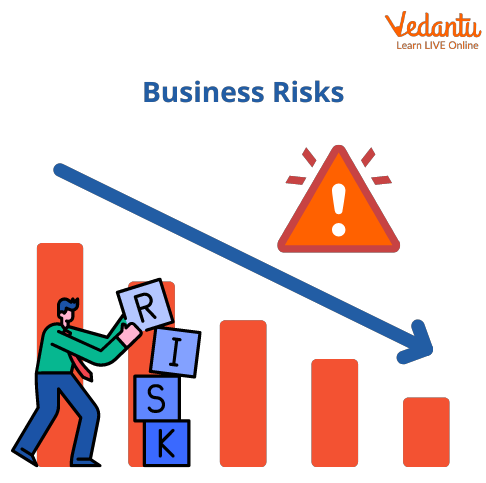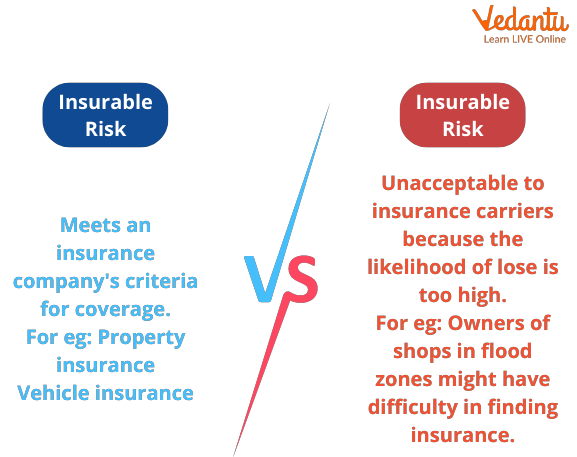




What is The Best Way to Define Business Risk?

Business Risk
What is The Best Way to Define Business Risk?
Business risks are related to how a company's operational profits, also known as earnings before interest and taxes, would react to fluctuations in sales. When using the cost of capital to evaluate investment options, it is assumed that the company's business risk will not change if the proposed projects are approved.
Business risk can be defined as the possibility of unfavourable events occurring that increase the likelihood of losses and decrease the likelihood of gains. Business risk refers to the possibility of insufficient profits or losses due to unpredictabilities such as shifts in consumer preferences, strikes, heightened competition, governmental policies, obsolescence, etc.
When conducting business, each company organisation faces unique risks. Business risks are situations that could cause a company to fail due to unanticipated future events that could affect profitability or represent a risk of loss. The types of initiatives that a company undertakes can have a significant impact on its business risk.
Different Types of Business Risk
Business risk can be classified into two broad categories:

Types of Business Risk
Insurable Risk
Insurable risks are those that can be recovered from. Insurable risks are losses that can be recovered or for which a company can receive compensation from an insurance provider. Natural and physical hazards, in general, are insurable risks. For example, businesspeople can obtain a fire insurance policy to protect themselves from floods, earthquakes, or asset damage such as boiler breaking, among other things.
Non-Insurable Risks
Non-insurable risks are those for which no insurance is available. The businessmen are not liable for any loss or change in demand caused by an employee's negligence or carelessness. Whether or not a risk is insured, only the loss can be split, but the risk remains.
Explain The Nature of Business Risk
The risk is lower for businesses that produce or buy necessities like salt, sugar, oil, cotton, etc. because the demand for most necessities is either inelastic or very slightly elastic. On the other hand, businesses that produce or buy luxury goods are more vulnerable to business risks since the market for these goods is highly elastic.
Business risk is the possibility that a company will incur losses rather than profits, that profits will be lower than expected or both. Many factors influence business risk, including sales volume, per-unit price, input prices, competition, general economic conditions, and governmental laws.
Is Caused by Uncertainty
The state of not knowing what will happen in the future is referred to as uncertainty. Uncertainties include changes in demand, governmental policies, technological advancements, etc. These unknowns increase business risk.
An Essential Component of Any Business
Risk is an important aspect of the business. Even though risk levels can vary, no firm can eliminate risk.
Profit as a Reward for Taking Risk
The company makes money by taking risks. There is no gain without risk; the greater the risk, the greater the reward. An entrepreneur takes a risk in the hope of profit.
Features of Business Risk
The following features could be used to highlight business risks:
The Present.
In the past, business risks were lower and more contained. Business risks are quite high in today's world of fierce competition, cutting-edge technology, and economic globalisation. Furthermore, business risks are likely to worsen in the future.
The Size of Your Company.
Small businesses benefit from operational flexibility and the ability to adapt quickly to changing conditions, making them less vulnerable to business risks. On the other hand, as a company grows in size, its flexibility decreases. Larger businesses are more vulnerable to business risks.
Explain The Causes of Business Risk
Natural Factors
Humans have no control over nature because it is an autonomous phenomenon. Natural disasters, such as earthquakes, floods, droughts, famines, and so on, significantly impact a company and can result in significant losses. Natural causes are unpredictability factors over which humans have no control.
Human Causes
Human causes are associated with the possibility of loss caused by people or organisation personnel. Employee dishonesty can result in significant financial losses for a company, for example, if an employee divulges a trade secret to a rival or commits fraud.
Workers may impede output by staging strikes, riots, or other protests. Furthermore, this could lead to difficult business situations. Price changes in the market are possible as a change in client needs, tastes, fashions, and preferences.
Financial causes
Economic factors are linked to the possibility of loss due to market changes. The level of competition may change. They all have an immediate impact on the company's profits.
Even minor changes in government policy can have a significant impact on business. For example, when the Janata government took office in 1971, the Coca-Cola Company and many other foreign corporations were deported back to India.
Physical Consequences
Physical factors include all factors that cause property loss, such as technological changes that render equipment obsolete or the use of antiquated technology, mechanical flaws that cause boilers to burst, worker accidents, etc.
Let’s take a look at Toyota's risk management framework and how the company recognises and manages risks. Provide a case study to understand business risk easily.
Toyota had surpassed GM to become the world's top vehicle seller by 2009, owing to its superior manufacturing techniques and reputation for producing high-quality automobiles. However, it would not last long at the top. The first Lexus vehicles were discovered to have jammed gas pedals, resulting in an abrupt and uncontrollable acceleration. Following the deaths, Toyota was forced to replace the defective pedals in over four million vehicles. The number grew significantly as a result of subsequent recalls that affected other Toyota products. The cost of the recalls was high, but it paled in comparison to the damage done to Toyota's reputation for quality, which was critical to its success.
In 2011, Toyota experienced yet another unexpected "accident." It was the magnitude 9 East Japan earthquake and tsunami. The Tohoku region, a hub for automobile production, suffered significant damage and fatalities. Toyota was forced to shut down four production lines that manufactured vehicles for the Japanese market. Furthermore, many of the local small suppliers on whom Toyota relied for parts had to close their doors. This put a strain on Toyota's supply chain, which had to be adjusted.
By that point, it was clear that Toyota needed to put a new emphasis on risk management. Risk management entails forecasting and assessing financial risks, as well as devising mitigation or avoidance strategies.
Conclusion
The company faces numerous risks, but these risks can be reduced by taking certain steps. Management can use a technique to reduce the likelihood of any given event resulting in a loss. Although hazards cannot be eliminated, they can be reduced.
As a result, policies that reduce loss are implemented. Sending the goods by train is less risky than sending them by air, for example. Sending the merchandise by train reduces the risk. Similarly, there is a higher risk when introducing a new product, so you may choose not to take the risk.
FAQs on Business Risk: Why It's Essential for Profits
1. What do you mean by Internal Business Risk?
Internal business risk is linked to the company's internal environment. The company must operate within its constrained environment due to internal business concerns. Internal business risks differ from one company to the next based on internal environment constraints. As a result, each company has a unique set of internal hazards, and its success depends on its ability to manage these risks.
Internal risks are those that arise as a result of events within the organisation. These risks are controllable because the likelihood of their occurrence can be estimated.
2. Define Business Risk.
The firm's activities' uncertainty is referred to as "business risk." This type of systematic risk involves future income or earnings volatility due to events, situations, conditions, acts, or inactions that make achieving goals and objectives and implementing strategies difficult.
Business risk is the expectation that the company will earn less than expected or even lose money due to inherent business risks such as competition, shifting consumer tastes and preferences, fluctuating input costs, shifting governmental policies, etc. It may make obtaining a return on investment more difficult for the company.
3. Give an example of Business Risk.
A business owner may face various risks, including manufacturing risks, raw material supply risks, equipment failure, labour unrest, etc. Marketing risks can arise from various market pricing changes, shifting trends and fashions, inaccurate sales projections, etc. Furthermore, the company's assets could be lost due to fire, flood, earthquakes, riots, war, or political turmoil, resulting in unwelcome business interruptions. As a result, different types of business risks may exist depending on the type and scale of the business.





















